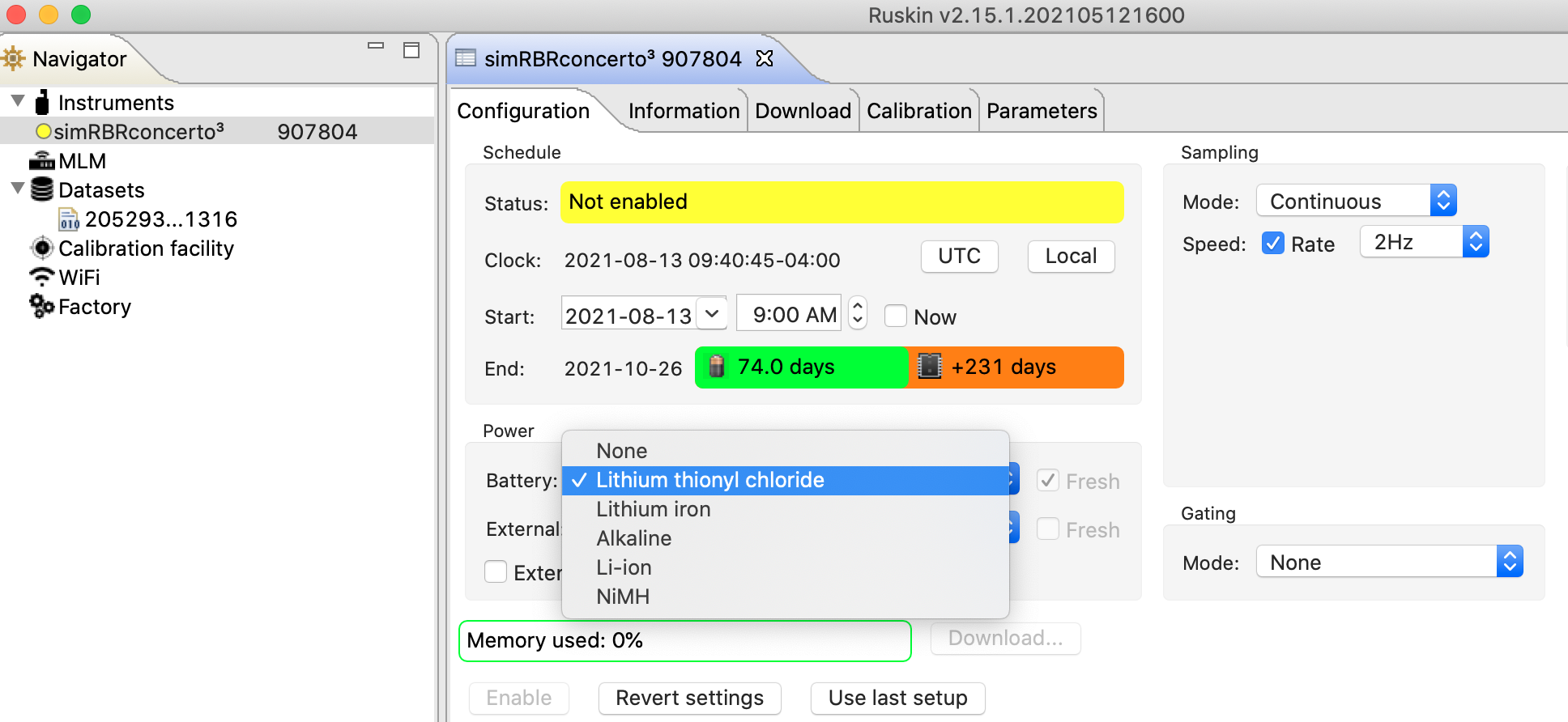Battery recommendations
See also the pertinent Ruskin user guides for battery types and their role in deployment times.
Most RBR instruments use AA-type cells. The only exception is the RBRquartz3 Q | plus, which uses D-type cells.
The batteries that provide the longest instrument life are the lithium thionyl chloride batteries (Li-SOCl2), however, there are some limitations with regards to current draw that means we will not always recommend Li-SOCl2, give them as an option as a battery type in Ruskin, nor ship them in the instruments by default.
Lithium thionyl chloride batteries are only recommended for T, D, T.D, C.T, C.T.D, and RBRquartz3 instruments. Any additional sensors will not work correctly on this type of battery.
Deployment times of a Generation3 instrument can be determined using Ruskin autonomy engine and are affected by the battery type selected, as well as by sampling power and instrument memory.
The "Battery" dropdown menu shows available chemistry options for internal batteries. The list depends on your instrument.

RBR ships all new instruments with fresh batteries of the highest capacity for the instrument type already installed.
Mixing batteries of different chemistries, brands, and age will reduce performance and potentially damage the instrument. Improperly matched batteries may become overheated, leak, or even explode.
AA-type batteries
Name | Chemistry | Voltage (V) | mAh* |
|---|---|---|---|
Lithium thionyl chloride | Li-SOCl2 | 3.6 | 2700 |
Lithium iron | Li-FeS2 | 1.5 | 3500 |
Alkaline | Zn-MnO2 | 1.5 | 2500 |
Li-ion | Li-NiMnCo | 3.6 | 750 |
Nickel metal hydride | Ni-MH | 1.2 | 2400 |
*The nominal capacity of each type of battery is given at room temperature.
D-type batteries
Name | Chemistry | Voltage (V) | mAh* |
|---|---|---|---|
Lithium thionyl chloride | Li-SOCL 2 | 3.6 | 18400 |
Alkaline | Zn-MnO2 | 1.5 | 16000 |
Nickel metal hydride | Ni-MH | 1.2 | 10000 |
*The nominal capacity of each type of battery is given at room temperature.
Compact instruments (SL3)
RBR compact instruments use a single AA chemistry battery. All T, D, and T.D instruments will ship with EVE ER14505 lithium thionyl chloride batteries installed. All other instruments ship with Energizer L91AA lithium iron. All other batteries (alkaline, Li-ion, and Ni-MH) outlined in the table above are also suitable for these instruments.
Standard Instruments (L3)
Most RBR standard instruments use AA chemistry batteries. All T, D, T.D, C.T.D, and RBRquartz3 will ship with EVE ER14505 lithium thionyl chloride batteries installed. All other instruments ship with Energizer L91AA lithium iron. All other batteries (alkaline, Li-ion, and Ni-MH) outlined in the table above are also suitable for these instruments.
RBRquartz3 Q | plus
The RBquartz3 Q | plus uses D-type batteries and is typically shipped with Tadiran TL-4930 lithium thionyl chloride.
Generation2 standard instruments
Loggers are powered by eight or sixteen 2/3A size 3V lithium cells. These are standard camera batteries and may be obtained from retail photographic or hardware outlets (see the following chart for model numbers).
Energizer | Kodak | IEC | Procell | Duracell | Rayovac | Panasonic | Varta |
|---|---|---|---|---|---|---|---|
EL123A | K123LA | CR17345 | PL123A | DL123A | RL123A | CR123A | CR123 |
Generation2 compact instruments
RBRsolo and RBRduet data loggers are powered by one (1) AA size 3.6V lithium thionyl chloride cell.
The logger will not operate with alkaline or zinc-chloride 1.5V AA batteries, you must use 3.6V LiSOCl2 battery. The instrument will not operate with rechargeable batteries. RBR uses the EVE brand batteries (part# ER14505) in your logger. Generally, lithium thionyl chloride cells are sensitive to orientation, and if the logger is placed with the positive end facing downward (logger sensor pointing up), it will suffer from decreased capacity and reduced battery life. Tadiran cells are also a good brand and are minimally sensitive to this orientation effect.
XR Series Instruments
These instruments use 2/3A size 3V lithium cells.
